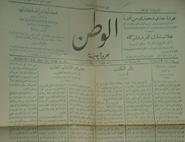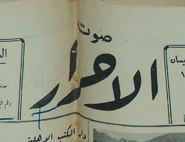| Search the Website |
|
History of the LNL
|
|||||
|
Viscount Philippe de Tarrazi
 His YouthA writer, poet, scholar, historian of the Arab Press, and dignitary of the Syriac Catholic community, Philippe de Tarrazi was born on May 28, 1865 in Beirut. His ancestors hailed from an Assyrian family originally from Mosul and had migrated to Alep before dispersing between the Levant and Egypt. His father, Nasrallah Antoine Tarrazi, known for his charity works in public and private circles, was awarded by His Holiness Pope Leo XIII the title of Count, which was inherited by his son Philippe. Philippe de Tarrazi learned Arabic and French at the Patriarcal School (1873-1875), and then joined the Jesuit College (1875-1884), where he obtained a science degree and learned Latin, Greek and Italian. His Social And Political ActivitiesAfter he graduated, he became a wealthy trader and travelled to several countries where he met many political and cultural figures (1899-1913).During World War I, he helped the needy. Accused of spying against the Ottoman Empire during the war, he was imprisoned for ten days and then released on bail. During his 81 days of trial, he was escorted from Beirut to Aley (his native village) until his innocence was proven. When the French army occupied the Syrian coast in 1918, the French government established the Directorate of Supply and appointed de Tarrazi General Inspector. A member of several commissions, de Tarrazi was appointed in 1919, along with French Army officers, to be a member of the Commission for the Evaluation of properties occupied by the soldiers. In this position, de Tarrazi endeavored to defend the rights and interests of his fellow countrymen. He also formed the Disaster Relief Commission for the nation's disaster-stricken population (1920). A member of more than fifteen organizations, including the Christian Union Association that was working for the independence of Greater Lebanon, he also presided over several others, including the St. Vincent de Paul Society (1898-1906), the Syriac Association for Charity Work, and the Brotherhood of the Holy Family. He enlisted in the Reform Association that called for reform from the Ottoman Empire. He also was elected a member of a number of scientific societies, including the German Society in Berlin for the study of the conditions in Muslim Countries, the Arab Academy of Damascus, the Syrian Academy in Beirut, the Commission for Beirut street names, the Librarian Association of France, and the Commission of the Al-Aqsa Library in Jerusalem. His Intellectual ActivitiesViscount de Tarrazi wrote in many magazines and newspapers. He also composed more than five thousand verses, mainly gathered in two volumes: Nafhat al Tib (Whiff of Perfume) which was unfortunately lost, and Kourat al Ain (Favorite).He was fond of antiques, which he collected with a lot of care. Starting 1889, he began collecting first issues of magazines and newspapers in several languages (Arabic, Turkish, Assyrian, Hebraic, Armenian, Persian, Tartar, Kurdish, Indian, Urdu, and others). He classified them methodically by publication date. The Arab collection alone reached some 1900 newspapers and magazines. In 1913, he wrote a book entitled "History of the Arab Press" which he described as "a comprehensive work of history of the Arab press, from East to West", and which is still considered as a reference today. He divided it into four sections with a prologue of eight chapters in which he presented the Arab press with its related ethics and historians. He concluded the book with a general list representing all newspapers, without exception, displayed by country of publication. In addition to a large collection of stamps, de Tarrazi also owned a collection of calligraphies of famous men and women from the East, including sultans, kings, ministers, princes, scholars, poets, and religious figures. He contributed to the promotion and dissemination of cultural writings. Indeed, he offered a large collection of books, manuscripts and printed documents – which he had received as donations from foreign cultural associations and academies – to Deir Al Charfeh School for Syriac Catholics (Lebanon) and to the Union of Journalists in Beirut. He also offered a large quantity of books to the Khedive Library in Cairo, the Imperial Library of Vienna, the British National Library in London, the Vatican Library in Rome, the Berlin State Library, the Library of Hamburg in Germany, the Library of the Oriental Languages School in Paris, Al-Aqsa Library in Jerusalem, the Library of the Benedictine Monks at the Mount of Olives, the Monastery of Mar Behnam in Mosul. He received more than twenty decorations. The Institution of the Great Library of BeirutAfter realizing that Beirut, the city of culture and knowledge, lacked a national library or merely a place where intellectuals could read and research, de Tarrazi submitted the idea of such an institution to the government. The Viscount's idea was approved, and he was commissioned to implement the project. Since then, he put all his efforts, time, and money at the service of this project. He thus instituted a library known as the "Great Library of Beirut" by firstly moving his private collection, which included valuable books – manuscripts and printed documents – and a large collection of magazines and newspapers, which formed the nucleus of the Library. He travelled to Europe at his own expense in the aim of developing the Library's collection. There, he gathered thousands of books from literary institutes, cultural institutions and academies. He also brought antiques to decorate the Library, whose walls he adorned with portraits immortalizing the country's famous intellectuals.On July 25, 1922, the official inauguration of the "Great Library of Beirut", located at the premises known as the "Deaconess" in the Center of Beirut, was held under the chairmanship of General Gouraud. De Tarrazi was appointed Secretary General of the institution until 1939. His DeathAt the end of his life, de Tarrazi lost his sight and was paralyzed. He died in Aley in 1956, and his body was transported to Beirut and was buried in the cemetery for Syriac Catholics.His WorksDe Tarrazi published several books and articles in Arabic on various topics. View the list of his publications.Sourcesمعجم المؤلّفين/ عمر كحالة، 1959: (فيلب طرّازي؛ فيليب بن نصر الله دي طرّازي؛ 1882-1375هـ = 1865-1956م) معجم المطبوعات العربيّة والمعرّبة، 1928: ص. 1237 (طرّازي، الويكنت فيليب؛ فيليب بن نصر الله بن أنطون بن نصر الله بن إلياس بن بطرس دي طرّازي) نبذة تاريخيّة عن دار الكتب اللبنانيّة، 1948: ص. 149 (الفيكونت فيليب دي طرّازي؛ 1865-) الموسوعة العربيّة، آخر مراجعة بتاريخ 06 نيسان 2011: (طرّازي، فيليب نصر الله؛ 1865ـ 1956...) http://www.arab-ency.com/index.php القاموس العام، 1923: ص. 51 (الفيكونت فيليب دي طرّازي) تاريخ الصحافة العربيّة، 1913: ص.3 Press releases: |


















